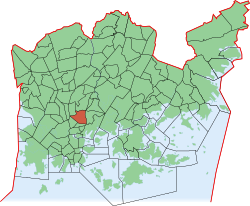Vallila
|
Vallila (Vallgård) District No. 22 of Helsinki |
|
|---|---|
| Coordinates | 60 ° 11 '40 " N , 24 ° 57' 24" E |
| surface | 1.3 km² |
| Residents | 8959 (Jan. 1, 2015) |
| Population density | 6892 inhabitants / km² |
| Jobs | 16,087 (Dec. 31, 2004) |
| Source: Helsinki City Statistics Office: Helsinki alueittain 2006 (PDF, 12 MB, Finnish) | |
Vallila ( Swedish Vallgård ) is a sub-area ( Finnish. Osa-alue ) and at the same time a district ( kaupunginosa ) of the Finnish capital Helsinki with almost 7200 inhabitants. Located east of Pasila and north of Kallio , it is one of the northernmost parts of downtown. Vallila, together with the sub-area / district of Hermanni, forms an urban district that also bears the name Vallila, and the total population of which is around 10,700.
The specialty of Vallila is the area known as Puu-Vallila ("Wooden Vallila"). This is an area with traditional wooden houses built between 1910–1927 and renovated in the 1980s. In the 19th century, such wooden houses had shaped the cityscape in large parts of Helsinki. Puu-Vallila is one of the few areas where this wooden house environment has remained unchanged to this day.
The 1975 film “ Mies, joka ei osannut sanoa ei ” (“The man who couldn't say no”) by Finnish director Risto Jarva takes place in Puu-Vallila, which was then threatened with demolition.


